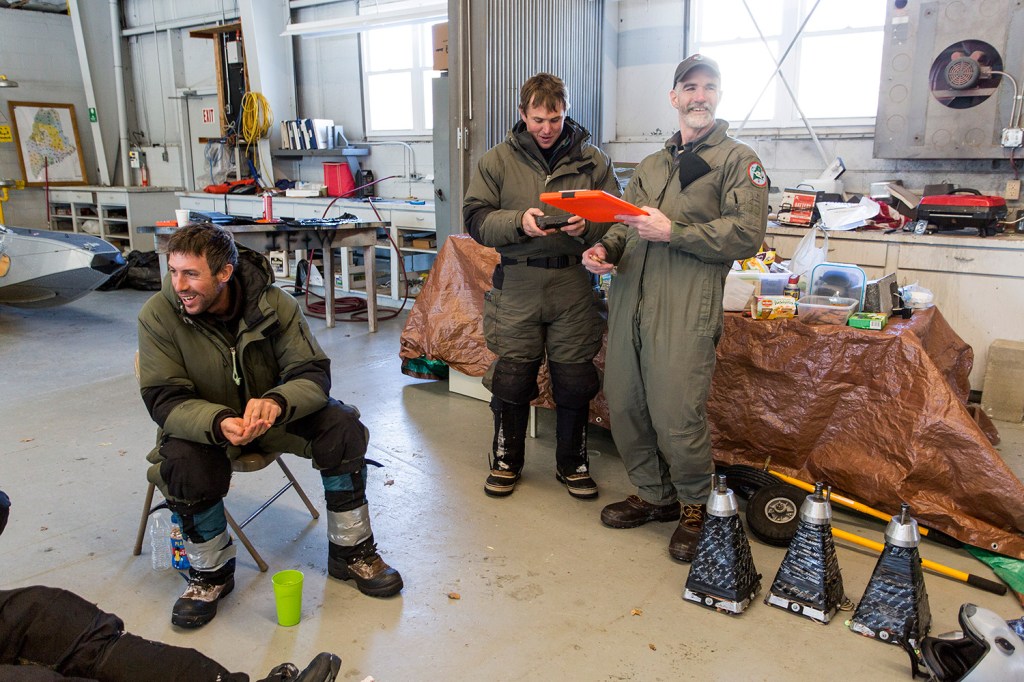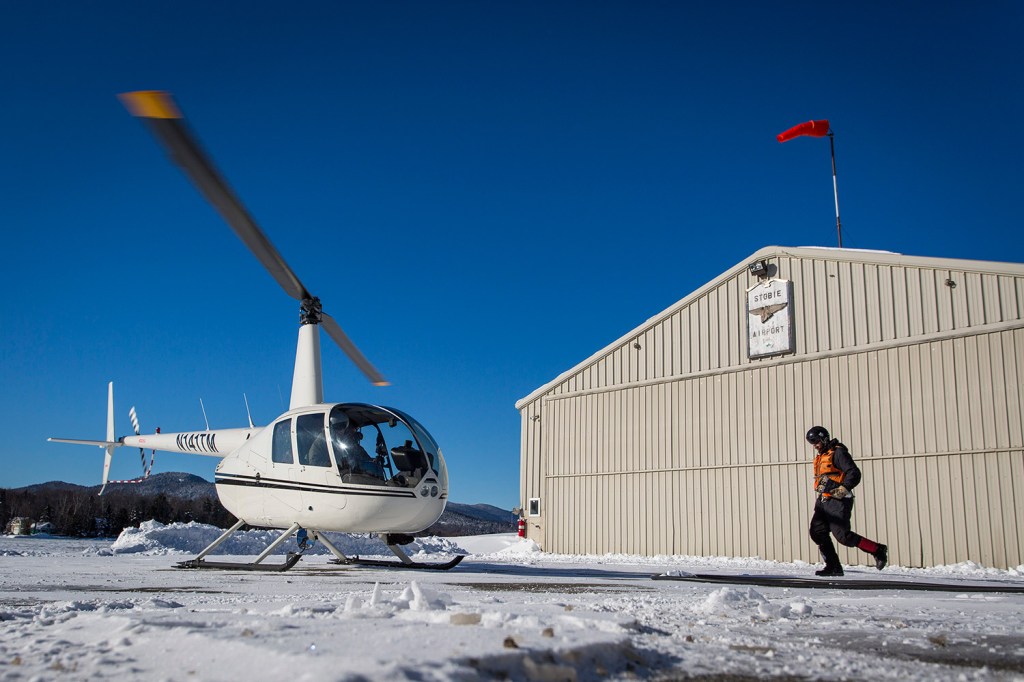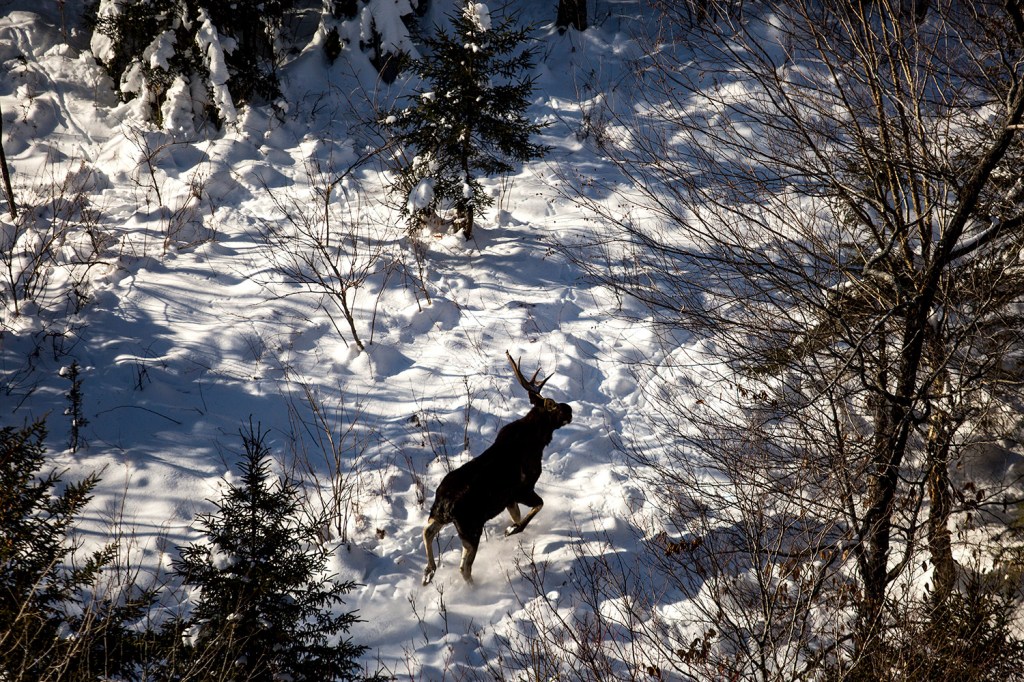GREENVILLE — It’s like a rodeo, Maine-style.
A three-man field crew flies in a helicopter above the woods near Moosehead Lake, the pilot getting as close to the treetops as he can. Once a moose is spotted, the crew’s “muggers” leap from the helicopter and wrestle the animal to the ground. They belt the moose’s legs, take blood and fecal samples and place a radio collar on it.
“In about 10 minutes we can get a moose sorted,” said veteran moose handler Sam Davison of Native Range Capture Services, a Nevada-based company contracted by Maine wildlife biologists to assist in what has emerged as the foremost study on moose survival in the Northeast.
Data from the radio-collar study, now entering its third year, is critical as biologists try to understand conditions that lead to winter-tick infestations among the state’s herd – and in what situations moose can gain the upper hand.
Winter ticks have taken a toll in recent years on moose from Maine to Alberta in Canada. In New Hampshire, which is partnering with Maine on the five-year study, the moose herd has dropped to 4,000 – a decline from 7,000 in the late ’90s.
Officials estimate Maine’s moose population at 60,000 to 70,000. That’s more than any other state in the contiguous U.S., but down from an estimated 75,000 in 2012. Concern about mortality caused by winter ticks was a chief reason that Maine reduced its moose-hunting permits by 25 percent in 2014 and by another 9 percent last year. The preliminary recommendation for 2016 hunting permits will be announced in two weeks.
The radio-collar study has been expanded this winter from the Jackman/Greenville area to Aroostook County, where the aerial-capture team recently collared 70 adult female and calf moose. Last week the team was near Moosehead Lake, where it intended to capture an additional 36 calves. All told, biologists from the Department of Inland Fisheries and Wildlife will be able to monitor 150 moose in the two study areas. In New Hampshire, another 90 moose have been collared to date near Errol, to the southwest of Greenville.
Biologists say they have yet to fully understand the impact that climate – or even the size of the moose herd – has on winter ticks. Lee Kantar, Maine’s moose biologist, said there is now some thought that smaller moose herds result in fewer cases of winter-tick infestation.
“There is evidence if you decrease the moose population, the less parasites you’ll have. But where is that sweet spot?” said Kantar.
TESTING THE THEORY
By design, Vermont’s moose population was cut in half seven years ago from 5,000 to 2,500 by increasing moose permits to see if it would result in a healthier herd, said Cedric Alexander, Vermont’s moose biologist since 1991. However, the moose population there has continued to decline, dropping to 2,000 in recent years. It’s unknown if winter ticks are the reason.
“Winter ticks have the capability of reducing moose populations down to very low levels, but (the moose) don’t disappear. At least that hasn’t been the case to this point,” said New Hampshire moose biologist Kristine Rines.
New Hampshire first started collaring moose in 2001 when biologists there noticed a winter-tick infestation, but it provided few answers, Rines said. They needed a study area farther north, and both Maine and New Hampshire hope the study area near Moosehead Lake will provide answers. Rines said Maine’s second study site near Ashland will provide even greater insight into what climates and under what conditions moose thrive. The two states share the information gathered.
Alexander is trying to raise funds so Vermont can join the radio-collar study. Minnesota, North Dakota, Colorado and some Canadian provinces all have seen declining moose populations.
“We all have concerns,” Kantar said. “We have all lost moose but we don’t know what it means long term. Will it stabilize? If you look at Minnesota, in their boundary territory moose are doing pretty good. Saskatchewan moose are colonizing new territory. And in North Dakota, it’s similar. We need to look at five to 10 years’ worth of research to understand more.”
‘A PILE OF MOOSE’
The project in Maine cost about $250,000 each of the past two years and is expected to cost $368,000 this year, according to Maine Wildlife Division’s director, Judy Camuso. Seventy-five percent of the study is financed through a federal grant funded by a tax on hunting equipment. The other 25 percent comes from grants and the state’s dedicated moose-research fund, which is funded by non-resident moose permits.
One day last week, the aerial crew was able to collar 12 moose near Moosehead Lake. Samples taken by the crew were flown to DIF&W headquarters in Greenville and eventually taken to a pathology laboratory at the University of Maine in Orono to be tested for disease.
Biologists can track the movement of the collared moose from transmissions sent twice a day. If a collared moose dies, the transmission emits a mortality signal. Biologists go out within at least 48 hours to do a necropsy on the moose, taking samples from vital organs that are sent to the UMaine laboratory.
In the spring of 2014, the first year of the study at Moosehead Lake, 22 of 30 (or 73 percent) of the collared calves died. Last year, 21 of 35 calves (60 percent) died.
While it’s still too early to draw any conclusions about how the Maine herd is faring this winter, there are positive signs that suggest it could be one of the “pockets of healthy moose” that Kantar said exist throughout North America.
In a separate survey taken from a helicopter, Kantar counted 164 moose around Greenville – more than he’s ever seen in a single day in the five years he’s done the aerial surveys. In the first group of 100, Kantar counted 44 calves, including three sets of twin calves. He said the high number of calves suggests a healthy herd around Moosehead Lake.
“I was pleasantly surprised,” Kantar said. “That’s a pile of moose.”
Send questions/comments to the editors.










Comments are no longer available on this story